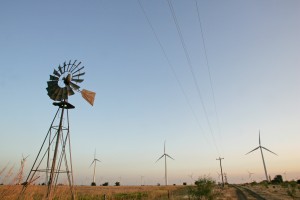What Do Plane Flights and Wind Farms Have in Common? Turbulence
Turbulence is a menace to more than just airplane passengers. As wind power grows in Texas and beyond, its impact on wind turbines is becoming a challenge for energy generation.
In a recent study released by the University of Texas at San Antonio, mechanical engineering professor Kiran Bhaganagar found that placing turbines too closely together in a wind farm causes a wake effect that reduces productivity. In some cases it turbines can lose up to 90 percent of the power they are capable of producing.
Turbulence, a term that gained its reputation by shaking up airplane rides, is known in the science world as a bumpy effect caused by air with conflicting velocities.
On any given wind farm, Bhaganagar says, turbulent wind gains momentum and has an increasingly negative impact as it moves down the line of turbines.
“The first one will give you maybe one hundred percent of the predicted power,” she says. “The second one is maybe giving 60 percent of the power, and as you go on, you might have turbines that are giving less than 10 percent of the power.”

Photo courtesy of UTSA
Bhaganagar says her research could increase revenue for wind energy companies around each other to yield higher energy.
But in order to produce enough energy to power a neighborhood of homes, Bhaganagar says “one turbine cannot do the purpose.” Large-scale production requires turbine farms.
As a state that leads the nation in wind energy production, wind comprised 12.1 percent of Texas’ electricity in April 2010. In fact, wind in West Texas travels at a constant speed of 17 mph.
Bhaganagar says once the wind energy industry incorporates her research to engineer wind farms, companies will begin to see profits rise. A different study from Texas Tech also shows that energy companies miss out on revenue from turbine underperformance.
In addition to turbulence, Bhaganagar says the wind energy industry faces a host of other environmental obstacles such as climate and the time of day. On hot summer days, when Texans demand energy the most, wind is relatively mellow.
Bhaganagar says the solution may be adding “smart controllers” that would influence the direction of the wind. The second stage of Bhaganagar’s research will look at how the turbines can be arranged to reduce turbulence.
